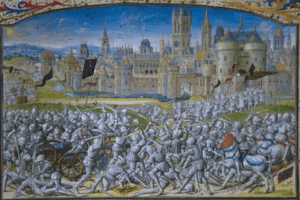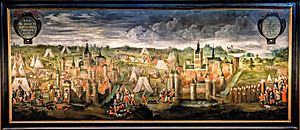Revolt of Ghent (1379–1385) facts for kids
Quick facts for kids Revolt of Ghent (1379–1385) |
|||||||
|---|---|---|---|---|---|---|---|
| Part of the Hundred Years' War | |||||||
 Battle of Beverhoutsveld in the chronicles of Jean Froissart (Berlin Staatsbibliothek, Preussischer Kulturbesitz / 15th century) with the people of Ghent under the black flag with white lion |
|||||||
|
|||||||
| Belligerents | |||||||
| Commanders and leaders | |||||||
The Revolt of Ghent (1379-1385) was a major uprising by the city of Ghent against its ruler, the count of Flanders, and the king of France. This rebellion lasted for six years.
Leaders like Jan Hyoens, Philip van Artevelde, and Frans Ackerman guided the people of Ghent. They fought against Count Louis II of Flanders, Duke Philip the Bold of Burgundy, and King Charles VI of France.
This revolt showed the growing power of ordinary citizens, especially the working class. It also highlighted Ghent's strong trade ties with England. These ties were strained because of the ongoing Hundred Years' War. In the end, Ghent accepted the duke's rule but avoided harsh punishment. The dream of Ghent becoming an independent city-state did not come true.
Contents
Why Did the Ghent Revolt Start?
The conflict began when Count Louis of Flanders, also known as Louis of Male, allowed the city of Bruges to dig a canal to the Lys river. This canal would have allowed Bruges to take over much of Ghent's trade. Ghent was a "staple port," meaning all goods had to pass through it, bringing the city a lot of money.
In May 1379, workers from Bruges started digging near Ghent. They were attacked by a group from Ghent called the White Chaperons. These rebels wore white hats as a symbol. When a local official arrested one of them, the people of Ghent reacted strongly.
They killed the official and burned down the count's new castle. Other forts in the area were also destroyed. Weavers, who were important cloth makers in Ghent, traveled to other Flemish towns. They encouraged a general revolt against Count Louis of Male. Only Oudenaarde and Dendermonde did not join the rebellion. Jan Hyoens, a key leader, died on October 1, 1379, and was given a grand funeral.
Philip van Artevelde Leads the Rebellion
The city of Ghent was blockaded, meaning no supplies could get in or out easily. Even with some help from other cities like Brussels, Leuven, and Liège, hunger became a serious problem. People grew desperate.
At a peace meeting, a deal was almost made. But inside Ghent, there was a fierce debate. Grain traders wanted peace, while weavers wanted to keep fighting. On January 24, 1382, the citizens gathered to decide.
A surprising new leader was chosen: Philip van Artevelde. He was the son of Jacob van Artevelde, who had led a revolt years before. Philip was made captain of Ghent and celebrated by the people.
Philip van Artevelde, with his trusted helper Peter van den Bossche, removed rivals. He even had the sons of those who killed his father executed. Artevelde wanted help from England, but he couldn't get military support. Despite his strong leadership, hunger forced him to negotiate for peace.
The count demanded that the people of Ghent appear before him with ropes around their necks, ready to accept his judgment. Artevelde refused. A few days later, on May 5, 1382, he led 4,000 Ghent rebels to Bruges. They surprised the count's army during a religious parade and won the Battle of Beverhoutsveld. Some of Bruges' own soldiers even switched sides during the fight. The count barely escaped, swimming across a canal at night.
French King Charles VI Intervenes
After this defeat, Count Louis of Male asked King Charles VI of France for help. Even though the king didn't fully trust the count, he agreed. His advisor, Duke Philip the Bold, warned that the Ghent revolt could inspire similar uprisings in France and other countries. King Charles VI wanted to stop these ideas from spreading.
The French army, with 10,000 soldiers, marched into Flanders. They met the Flemish army led by Artevelde at the Battle of Roosebeke. The French saw this as a holy fight. The Ghent rebels were quickly defeated in about two hours. Philip van Artevelde was killed in the battle.
Frans Ackerman Continues the Fight
Even after their victory at Roosebeke, the French couldn't fully defeat Ghent. They went to loot another city, then had to rush back to France because Paris and other cities had revolted. Frans Ackerman took over leadership of the Ghent rebellion, along with Peter van den Bossche.
By late 1382, England decided to get involved. Bishop Henry Despenser of Norwich landed in Calais with his troops in the spring of 1383. With help from Ghent, he won the Battle of Dunkirk. Then he captured several Flemish cities.
On the advice of his Ghent allies, Despenser started a siege of Ypres on June 8. The people of Ypres fought bravely. A new French and Burgundian army arrived in August to help Ypres. The English had to retreat. This was bad news for Ghent. However, Ghent then captured Oudenaarde to control the Scheldt river.
Meanwhile, France and England were talking about peace. To Count Louis of Male's surprise, Ghent was happy with the outcome. On January 26, 1384, a general truce was agreed upon. The old count died a few days later, and Philip the Bold became the new ruler. This seemed to bring peace, but some actions by the new duke's officials kept the anger simmering.
The Battle for Damme
Another change in the Hundred Years' War led to new fighting. In July 1385, 1,300 Ghent rebels led by Frans Ackerman captured Damme. Their goal was to cut off the French king from his fleet in Sluys, which he planned to use to invade England.
King Charles VI and Philip the Bold moved to retake Damme. Ackerman and his English archers, along with cannons, put up a strong fight. On August 16, Ackerman and his followers secretly left the besieged city. Perhaps he heard his power in Ghent was in danger.
The remaining troops fought hard. They tried to break through the enemy lines on August 26 but were discovered and killed. The next day, the French stormed the city and burned it down. About 200 rebels who survived were taken to Bruges and beheaded.
For Philip the Bold, defeating Ghent became more important than invading England. He advanced on Ghent with King Charles VI. They realized Ghent was very hard to capture. They pillaged the surrounding area until winter arrived.
By then, everyone was tired of the war. The people of Ghent were exhausted. The French wanted to invade England. The Duke of Burgundy didn't want to keep destroying his richest territory.
Peace and Its Results
Philip the Bold's advisor suggested he be generous. The duke followed this advice. In December, he surprised the Ghent envoy with very fair peace terms. There was a moment when the Ghent delegation almost refused, but finally, the Peace of Tournai was signed on December 18, 1385.
The citizens of Ghent agreed to obey the duke and end their alliance with England. In return, the duke promised no punishment. He granted an amnesty, meaning everyone involved in the revolt was forgiven. This also applied to towns that had helped Ghent. People who had been exiled were allowed to return, and prisoners were released. All of Ghent's special rights and privileges were kept. The city was even allowed to choose which pope they recognized.
Philip's generosity made his rule stronger. There were no more revolts in Flanders until his death in 1404. This peace was very important for the economy. The six years of fighting had badly hurt trade and business in Flanders.
The next major revolt by the guilds and the city of Ghent happened much later, from 1449 to 1453. That was against Duke Philip the Good, who wanted to tax the city directly and have more control.
The Legend of the "Gentse Heren"
There's a story about the Ghent delegation during the peace talks. They proudly called themselves "gentlemen" (Heren). The legend says they weren't given seat cushions. So, they folded their fancy cloaks to sit on and then dramatically left the talks in protest.
Another part of the story says they refused to get off their horses to greet the duke and his group. These actions supposedly earned the people of Ghent the nickname Seigneurs de Gand ("Lords of Ghent") from the Burgundians. These stories are probably just legends, not actual history.


